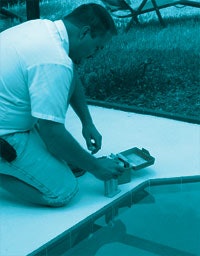
Still, traditionally, the most common approach to the problem of algae in pools has been to fight it with chlorine, and when chlorine fails and algae blooms, attack it with algaecide. Pool chemical experts have advised service techs to apply regular doses of algaecide as a backup, but that's far from universal practice.
Another approach, long available to the service tech, has been to starve the bastards by taking away their food. The idea of removing phosphates is not new, but it is gaining momentum alongside the growth of salt chlorine generators, according to Laura Minert, marketing director for Herb's Pool Service, Petaluma, Calif.
Herb's, and a number of other service companies, offer algae prevention programs to their customers to proactively fight the scourge. These programs also add a tidy sum to the bottom line, as they dovetail nicely with existing routes and contracts.
Four Programs, Coast-To-Coast
1. Petaluma, Calif.
Phosphate control starts in the early spring, as the 53 employees of Herb's Pool Service begin working to get 1,900 pools ready for the swimming season. Of special concern are the pools with salt systems, Minert says.
According to Minert, phosphates are a particular problem in salt chlorine pools. That assertion is widely held, she says, but the details differ. Some believe phosphates cling to a salt cell and do not allow it to work properly.
Others have read research done by Pristiva, a salt producer, that indicate some commonly used pool chemicals degrade into phosphates in the extremely acidic environment inside the salt generator cell.
"In any case, phosphates are food for algae," Minert says, "so if you have a system that's generating small amounts of chlorine at a time, which is what salt systems do, the phosphates are feeding algae, which is using up this small amount of chlorine that the salt generator is putting out and making it difficult to keep up with demand.
In short, modern salt pools are rarely shocked, a procedure that used to clear up a lot of algae problems.
"That's the reason we learned so much about phosphates when salt generators came along, because, let's face it, when a customer came in our stores prior to salt systems and they were low on chlorine, we told them, go shock your pool. And of course, adding gallons of chlorine was enough to bring the pool back."
To put it another way, in the absence of a good shock, phosphate control can keep pools clear of algae. So when Herb's is getting ready to put customers back on their salt systems in the spring, the company checks salt levels, chemistry and phosphates as a matter of routine. If a pool shows a reading in the high range, the company recommends a phosphate removal treatment, which bills out at $40.
"And then, periodically, if a customer has had problems with high phosphate levels, we'll test again," Minert says. "Eventually they'll build back up to a level where we have to treat again. It could be three months, six months, it depends on the pool."
2. Orlando, Fla.
Blue Water Pool & Repair Corp. of Orlando has taken a more comprehensive approach, according to Fred Johnson, operations manager. It started out having all service techs check the phosphate levels in every pool, giving the company a good sense of phosphate levels in general before contacting customers.
"Then we sent out a letter to the homeowners," he says, "stating that this is the best time of year to look at algae and phosphates - the temperature is rising, algae is growing, etc. And we explained that the phosphates are food for algae, and they can get into your pool from a variety of sources - soap, shampoo, fertilizer and other sources - and they are one of the main sources of algae blooms.
"Anyway, when we first did this, we charged it out at $90 a pool. The company owner was a little hesitant, thinking that the homeowners wouldn't want to do it, and that we'd be losing customers. But we finally sent out the letter."
The response surprised everyone. Out of about 300 pools, only 35 declined the treatment.
Even with a success rate near 90 percent, a patient educational effort was required. "A lot of people called, but after we explained to them the problem and the benefits, how once you remove phosphates, a pool is easier to maintain because phosphates tie up a lot of chlorine, we were able to win most of them over."
The second year, the response went from 35 "nos" to 19.
"After the first year that we tried it," Johnson says, "we got calls from people asking us to come out and do it again, saying their pools had never looked as good as they had last year. We got really positive feedback from it. So this year, when we sent out the letter, we said, 'In response to the popularity of the phosphate removal program last year, we will begin treatments starting on this date.'
"The thing is, you're really providing the customer with an excellent service, because the pools have never looked better."
3. Austin, Texas
Down in Austin, Texas, at Hines Pool, Andy Hines runs a less formalized phosphate removal program. Service techs keep an eye out for algae risk factors and run individual tests instead of making a phosphate exam part of the standard battery.
"If there's a lot of foliage around the swimming pool," he says, "we assume we have some phosphates, so we will go ahead and test for them. And if there is an elevated level we will use a phosphate remover.
"It's become a bigger part of our arsenal in the last few years, because, as you know, phosphates are a wonderful source of food for algae. At one point it was just the really cantankerous algae problems that we would treat, but now at the first sight of algae we'll do a phosphate test and treat accordingly."
4. Seattle, Wash.
At Master Pools in Mountlake Terrace, a suburb of Seattle, phosphate removal is not broken out into its own separate service, but left as a component of the standard package. Nancy Davis, cleaning and maintenance manager, believes it has paid off with increased profit at the company's retail store, and by burnishing the image of its service wing.
"We started using phosphate remover in the service department a few years ago. It was just kind of something I thought I'd try because I had a couple of problem pools and I thought, well, why not?
"And it worked. So then I started using it on all the cleaning and maintenance pools. Once we get the phosphates out we follow up with a maintenance dose. It doesn't solve all your problems, but it does help. It's part of our normal cleaning and maintenance regimen.
"I didn't really have to start 'selling it' until I started working in the retail store. For the customers that have used it in the past, it's part of their buy. When they come in, it's one of the things they're after."
Explanation Needed
There is some "selling" required, as Davis puts it.
Most pool owners recognize the terms "chlorine" and "clarifier." But these four companies have come to them with an unfamiliar product that attacks a problem they didn't know they had. To the trusting mind, this seems understandable if properly explained. To the suspicious, it may seem like a come-on.
Companies have to deal with that head-on, Johnson says. "Some people will say, and I've heard this from customers, 'You're treating my pool anyways, why do I need to buy additional chemicals?'
"You'll get calls like that, and you've got to be ready to answer them. And we simply tell them that the phosphates in your pool must be removed or they will feed algae. And phosphate remover is just like any other chemical we add, which we charge out for as well.
"If we don't use it," Johnson adds, "and they call us up and tell us they have an algae bloom, we're going to have to use chemicals to clean that up. And those chemicals cost more money. What we're doing with the program is a preemptive strike. We're being proactive in their pool care.
"I tell them that phosphates are an important part of pool care that need to be addressed. We're a high-tech company, we stay on the cutting edge, and we want your pool to be perfect, and this is how we do it."
When possible, it helps to show the customer the phosphate reading, rather than just tell them about it, says Minert. "We sell a lot of phosphate remover," she says, "but we sell it based on a phosphate test that clearly shows high levels of phosphate. I mean it's one thing to put a number on a lab report, but it's another to shake a vial in front of a customer and have it change from clear to dark blue, then the home-owner says, 'Wow, what's happening with my pool?'
"It's proof. So we have our employees walk over to the homeowner with that vial and say, 'Look, I just ran a test for phosphates, this vial should be clear. Instead, as you can see, it's bright blue. Let's just treat it and remove it. Your pool will look better because your chlorine will work better.'"
Despite the necessity of this type of customer persuasion, and even some rejection of the new treatment regimen, Johnson is very enthusiastic about the addition to Blue Water Pool's chemical lineup.
"You can really make a lot of money with this. Even on a 200-pool route, and say you only charge $70, you're averaging about $40 in profit per pool. So that's, what, an $8,000 profit?
"Because it's not like it's another service call or something, that's just your pool tech pouring in chemicals while he's there.
"And the thing about it is that it works."
Comments or thoughts on this article? Please e-mail [email protected].








































